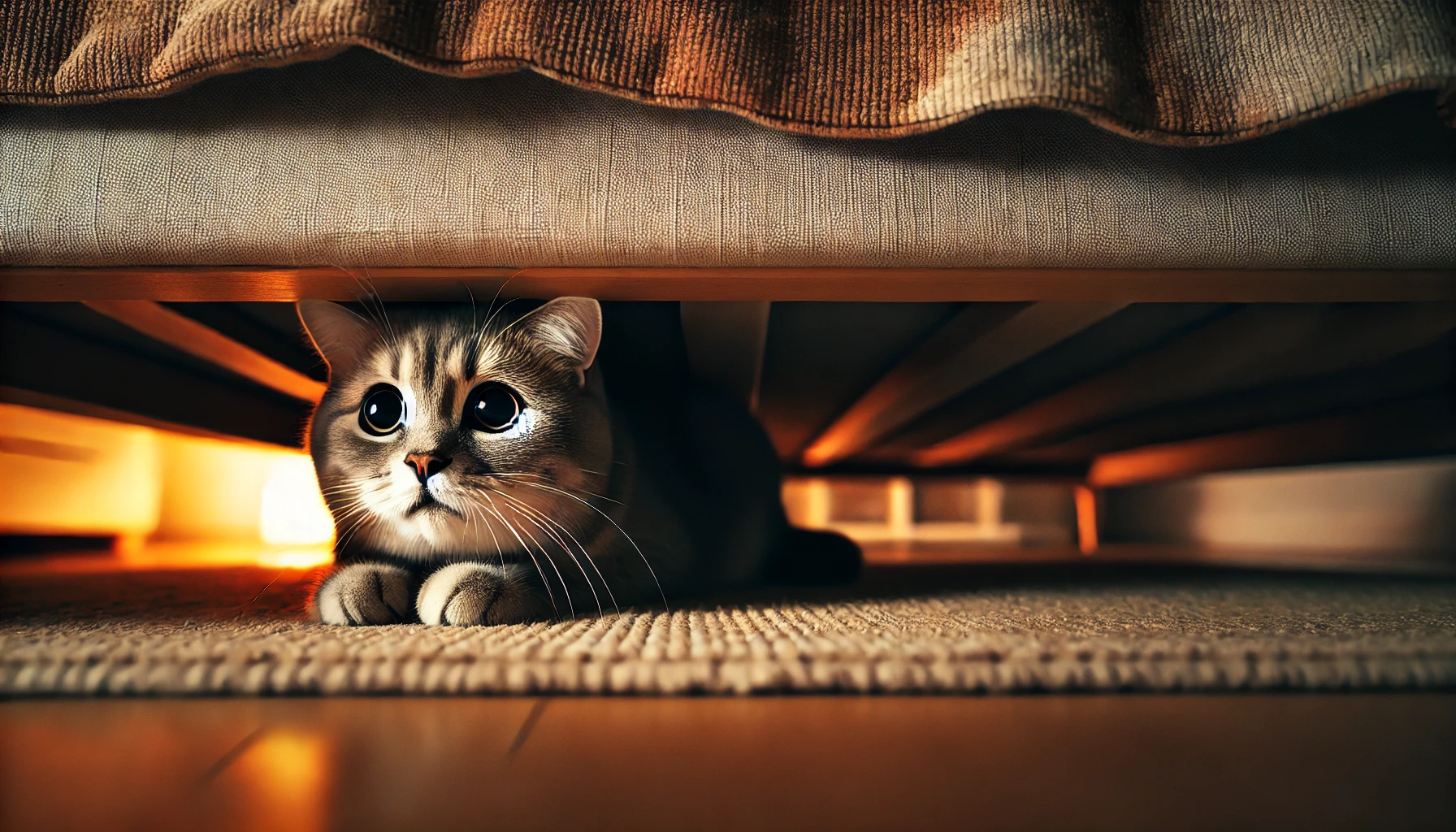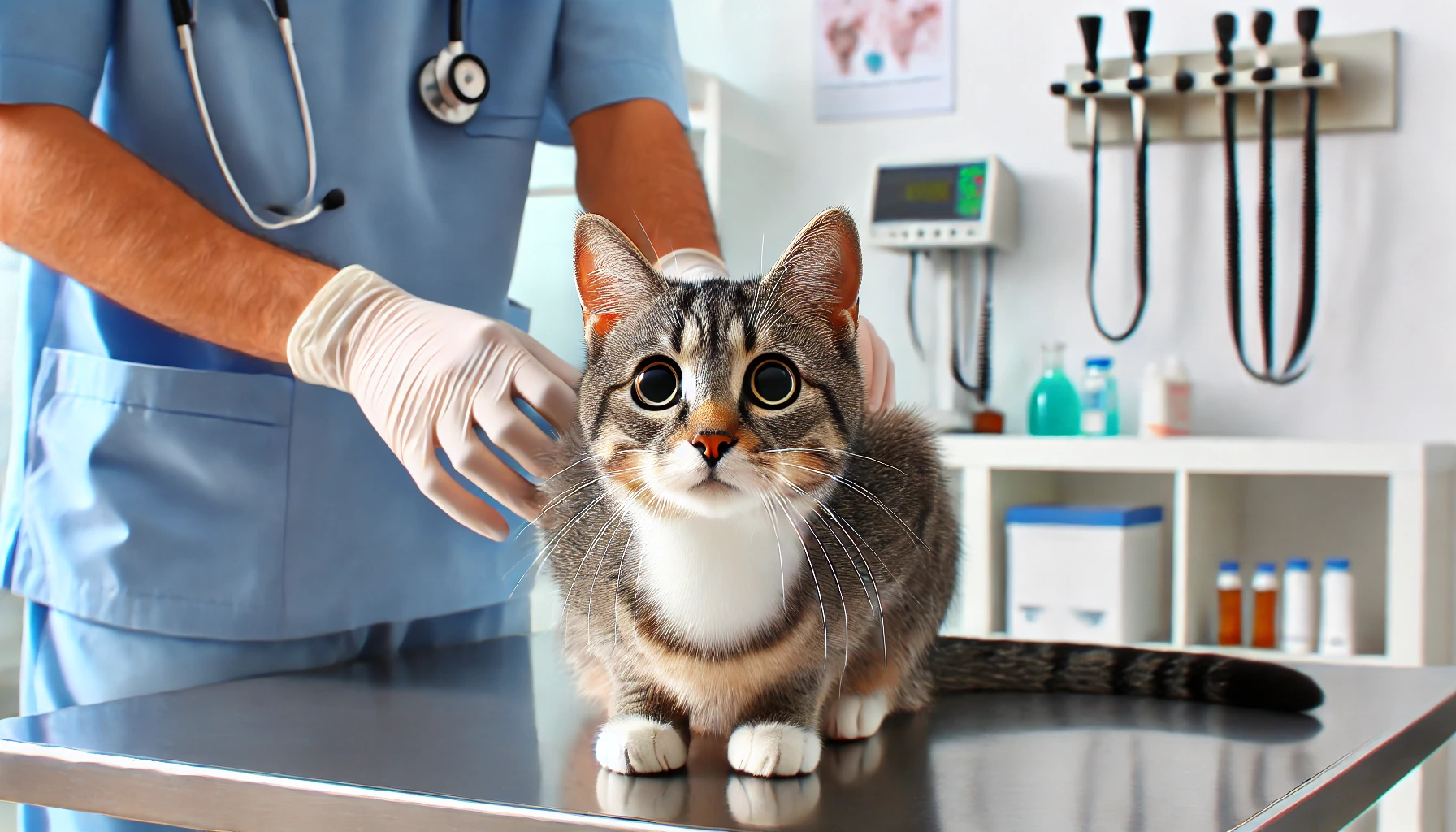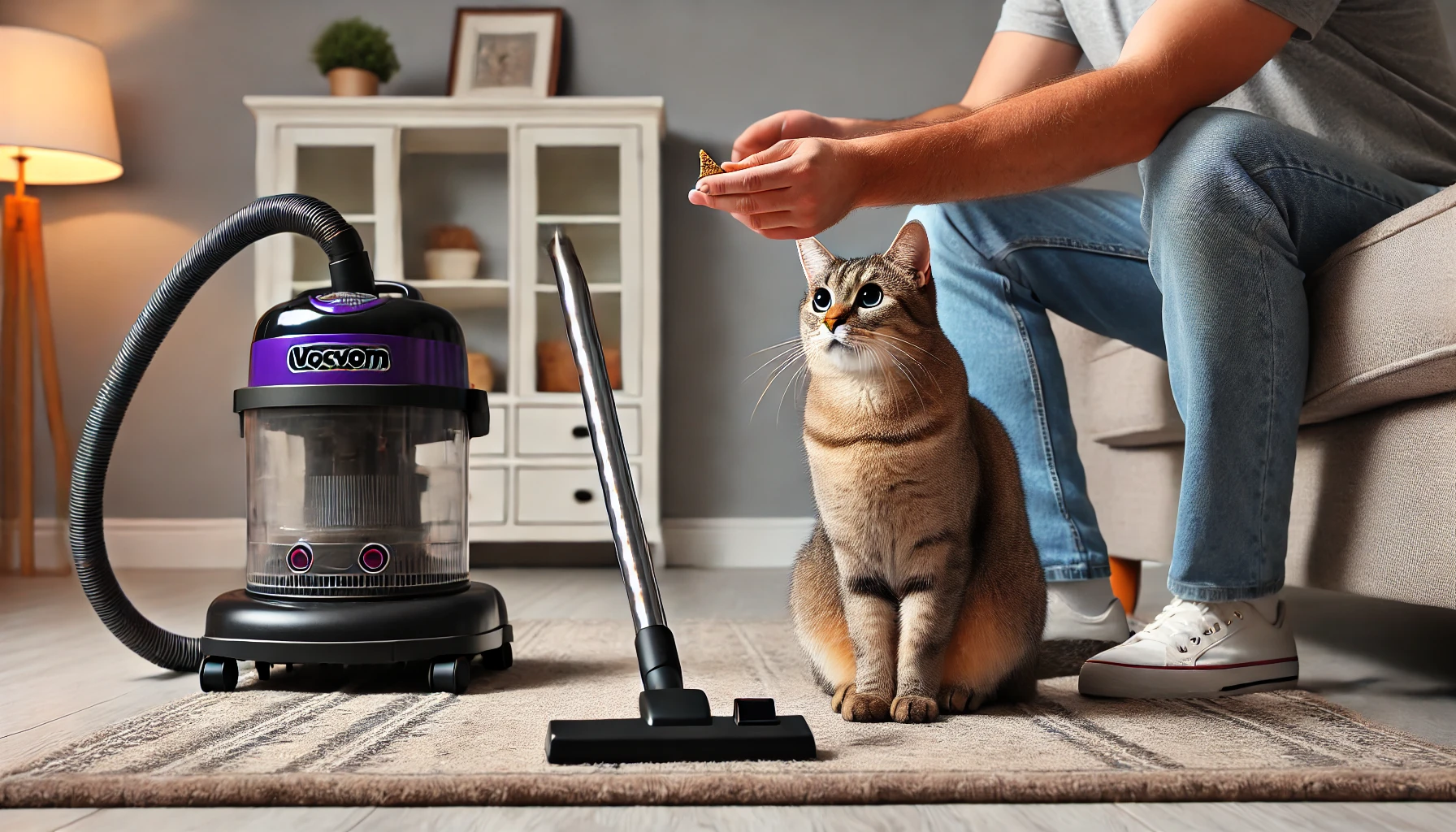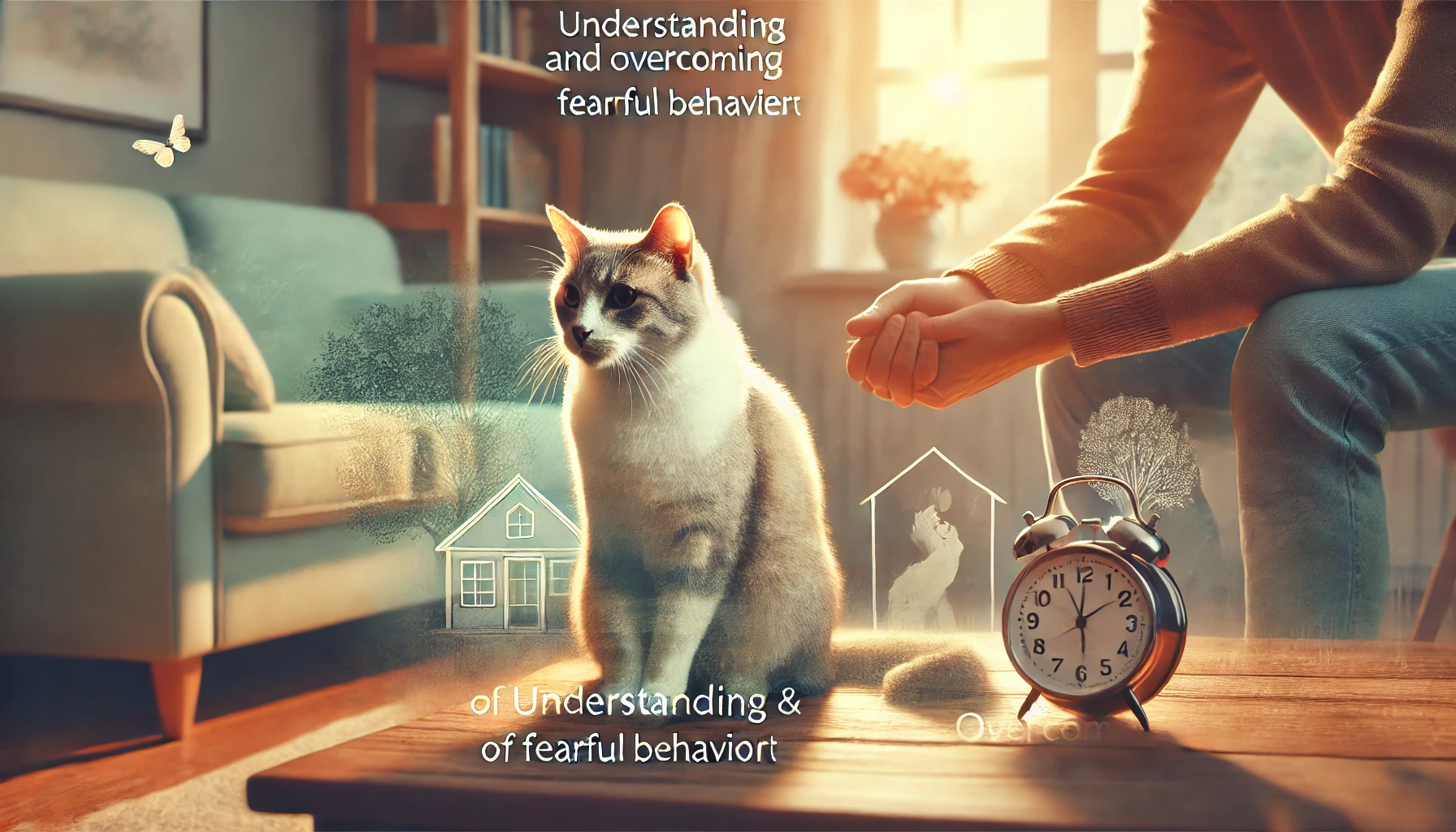Understanding and Addressing Fearful Behavior in Cats

Cats are mysterious animals known for their independent and agile nature, often exhibiting unpredictable behaviors.
While many cats are naturally confident and curious, some display fearful behavior that can be surprising to their owners.
Fearful behavior in cats can manifest in various forms, ranging from hiding under the bed to hissing or refusing to eat.
If these symptoms sound familiar, it’s important to understand that the causes of fearful behavior are usually deeper and can be addressed with the right approach.
In this article, we’ll explore the causes of fearful behavior in cats and how you can help your feline friend overcome their fears for a happier, more relaxed life.
Addressing fearful behavior in cats requires both patience and a keen observation of their actions.
Factors such as past traumas, genetics, and environmental changes can all contribute to a cat’s fearful reactions.
By recognizing the signs early and understanding the root causes of these fears, you’ll be able to offer your pet a supportive and comforting environment.
Table of Contents
Recognizing Fearful Behavior in Cats
The first step in addressing a cat’s fear is understanding how cats express their fear.
Unlike humans or dogs, cats often show subtle signs of fearful behavior, which owners may not notice right away.
Cats may not be as vocal as dogs, but their actions reveal a lot.
By learning to recognize these behaviors, you can better help your cat manage its fear.

Common Signs of Fear in Cats
Cats show their fear in a number of ways.
Some of the more common signs of fearful behavior in cats include:
- Hiding in small spaces, such as under the bed or in the closet.
- Avoiding eye contact or crouching low to the ground.
- Flattening their ears or arching their back.
- Excessive grooming or neglecting grooming entirely.
- Loss of appetite or failure to use the litter box.
Every cat is unique, so it’s important to observe your cat’s specific behavior patterns to determine if it is acting out of fear.

How Cats Show Fear Differently Than Dogs
It’s important to note that cats and dogs show fearful behavior in different ways.
While a dog may bark, whine, or cling to their owner, a fearful cat is more likely to retreat or become defensive.
Cats may freeze, hiss, or swat when they feel threatened, whereas dogs often seek reassurance from their owners.
Understanding these differences is crucial to providing the appropriate support for your cat when they are feeling afraid.
By recognizing these behaviors and understanding how cats show fearful behavior, you can start minimizing their anxiety and creating a more comforting environment.
Recognizing Fearful Behavior
Understanding how to identify fearful behavior in cats is crucial for providing the right support. The signs can be subtle, and early recognition can lead to more effective interventions.

Causes of Fearful Behavior in Cats
Addressing fearful behavior in cats requires, first and foremost, an understanding of the underlying causes.
Cats can become fearful due to various factors, from genetics to life experiences.
Knowing these causes will help you address your cat’s fearful behavior from the root, rather than merely managing the symptoms.
Common causes of fearful behavior in cats include traumatic experiences, poor early socialization, and environmental changes.

Genetics and Early Socialization
Interestingly, genetics can play a major role in how a cat reacts to stress and fear.
Some breeds, due to their genetic background, may be more prone to anxiety and fearful behavior.
Additionally, poor socialization during the critical developmental period—between 2 to 7 weeks of age—can result in a cat growing up fearful.
Cats not exposed to different environments, people, or other animals during this time are more likely to develop anxiety or fear-based behaviors later in life.
If you’ve adopted your cat as an adult, understanding its history might be challenging.
However, you can still improve your cat’s socialization through controlled, gradual exposure to new stimuli.

Traumatic Experiences and Environmental Factors
Events like abuse or abandonment can result in long-lasting fear responses in cats.
Even a frightening experience with another animal can make a cat fearful.
Environmental changes, such as moving to a new home, the introduction of new pets, or loud noises like fireworks or thunderstorms, can trigger fearful behavior even in previously calm cats.
Maintaining a predictable and stable environment can help make your cat feel more secure.
- Sudden changes in living space.
- New pets or unfamiliar animals in the home.
- Loud noises, such as construction, fireworks, or loud music.
- Changes in their routine, like feeding times or relocating the litter box.
Identifying environmental factors that may be causing your cat’s fearful behavior will help you adjust their surroundings to reduce anxiety.

Fear-Inducing Triggers in the Home
Sometimes, the things that trigger fear in a cat are subtle and easily overlooked.
A specific room or object in your house might remind your cat of a traumatic experience.
Some cats are sensitive to the smells of cleaning products, perfumes, or even plastic, which may provoke a fear response.
Understanding these triggers will help you create a more comfortable environment for your cat.

Health-Related Causes of Fearful Reactions
Health issues can also be a source of fearful behavior in cats.
If your cat suddenly starts displaying fearful behaviors, it may be due to pain or discomfort caused by an underlying medical condition.
Conditions like arthritis, dental pain, or the loss of vision and hearing can make a cat feel vulnerable and more fearful.
Regular veterinary checkups are essential to rule out any health-related causes of fear.
By understanding the root cause of your cat’s fearful behavior, you’ll be better equipped to help them overcome their fears and live a more confident, relaxed life.
Understanding Causes
Understanding the root causes of fearful behavior allows you to tailor your approach to better assist your cat. It’s not just about managing symptoms but addressing the underlying issues.

Creating a Safe Space for Fearful Cats
Setting up a secure, comforting environment is vital in helping your fearful cat.
Cats are sensitive animals, and their environment can either calm or exacerbate fearful behavior.
A well-thought-out environment, free from stressors, allows your cat to feel safe, helping them gradually build confidence.
By addressing their needs and using consistent positive reinforcement, you can help your cat reduce fear and anxiety.

Setting Up a Safe Space for Your Cat
One of the best things you can do for a fearful cat is to create a dedicated safe space in your home.
This area should be quiet, comfortable, and away from sudden noises or high foot traffic.
It can be as simple as a cozy bed in a quiet corner or as elaborate as a whole room set aside as a safe zone for your cat.
- Make the area inviting by adding soft bedding and favorite toys.
- Provide vertical spaces, such as cat trees or shelves, as many cats feel safer observing their surroundings from a height.
- Keep the area consistent and avoid changing its location or layout, as familiarity is key for your cat to feel secure.
This safe zone should also contain essentials like food, water, and a litter box, so your cat doesn’t need to venture into potentially stressful areas of the house.

Using Calming Tools and Products
There are several calming aids and products available that can help reduce fearful behavior in cats.
Pheromone diffusers, for example, release synthetic versions of calming pheromones that cats naturally produce, helping them feel secure.
Calming collars and sprays can also be useful during stressful events, like vet visits or thunderstorms.
- Pheromone diffusers: Plug-in devices that release calming chemicals to help cats feel more relaxed in a given environment.
- Calming collars: Collars treated with calming ingredients that cats can wear to reduce anxiety.
- Music or white noise: Playing calming music or white noise can mask stressful sounds like fireworks or construction noise.
These tools should complement behavior modification techniques and the establishment of a safe environment.

Using Positive Reinforcement
Positive reinforcement is one of the most effective tools for building the confidence of a fearful cat.
Instead of punishing fearful behavior, reward your cat when they display brave or calm actions.
Rewards can include treats, gentle petting, or playtime.
- Use treats to encourage your cat to explore new areas or objects.
- Reward your cat for approaching you or coming out of hiding.
- Avoid forcing your cat into stressful situations, allowing them to come out of their comfort zone at their own pace.
Consistency in positive reinforcement is key, and over time, your cat will associate formerly stressful situations with positive experiences.

Managing Noise and Other Stressful Stimuli
Loud noises or sudden sounds can trigger fearful behavior in cats.
To reduce fear in your home, it’s important to manage these stimuli.
If your cat is particularly sensitive to noise, consider the following tips:
- Use heavy curtains, carpets, or other soundproofing methods to reduce noise levels in the house.
- During loud events, like fireworks or parties, keep your cat in their safe space and play music or white noise to mask external sounds.
- Avoid making loud noises that could startle your cat, such as slamming doors or dropping objects.
By minimizing potentially distressing stimuli, you’re creating an environment where your cat can feel secure.

Understanding Your Cat’s Body Language
Paying attention to your cat’s body language will help you recognize when they are feeling fearful or anxious.
Cats communicate their feelings through subtle signals.
Some common signs of fear in cats include:
- Flattening their ears or lowering their body to the ground.
- Swishing their tail rapidly or holding it low.
- Wide eyes with dilated pupils.
Recognizing these cues allows you to intervene before your cat’s fear escalates.
Approach your cat slowly and offer reassurance, either by sitting near them or speaking in a calm, soothing voice.
By understanding their body language, you can respond appropriately to their fear and provide the comfort they need.
Safe Space Importance
Creating a safe and secure environment is essential for your cat’s well-being. This space should be comforting and free from stressors to help your cat gradually build confidence.

Training and Behavioral Techniques to Reduce Fear
Various training and behavioral techniques can help a cat overcome fearful behavior.
You can minimize your cat’s fears with patience over time by gradually introducing them to new experiences and associating those experiences with positive reinforcement.
Always move at your cat’s pace, as going too fast can increase anxiety.

Socializing Your Cat Gradually to New Experiences
One effective technique for reducing fearful behavior in cats is gradual exposure to new experiences, environments, or stimuli.
This process is known as desensitization, which involves exposing your cat slowly to a fear-inducing situation in a controlled manner.
For instance, if your cat is afraid of a certain room or object, allow them to become familiar with it at their own pace, rewarding them with treats or gentle stroking when they approach.
Gradually increase the exposure time as your cat becomes more relaxed.
- Always let your cat retreat if they feel overwhelmed; never force them to confront their fear.
- Pair new experiences with positive stimuli, such as favorite treats or toys, to create a positive association.
This technique works much better when done slowly and gradually, allowing your cat to feel secure rather than threatened.

Desensitization and Counter-Conditioning
Desensitization involves exposing your cat to what causes fear in small, controlled doses, while counter-conditioning helps change your cat’s emotional response to those stimuli.
For example, if your cat is afraid of the vacuum cleaner, start by simply turning it on in another room, far enough away that the noise isn’t overwhelming.
Reward your cat with treats for remaining calm.
Over time, you can gradually move the vacuum closer while continuing to reward calm behavior.
- Break the feared event down into small, manageable steps.
- Use plenty of treats, praise, and play to reward calm behavior.
- Gradually increase the intensity of the stimulus, such as sound or proximity, as your cat becomes comfortable.
Desensitization and counter-conditioning can take time, but they are powerful methods to help your cat change their fearful responses.

The Role of Routine in Building Confidence
A fearful cat needs predictability and routine for a sense of security.
Cats thrive on routines, and changes in their daily schedule can be anxiety-provoking.
Feeding, playing, and bedtime should remain consistent to minimize stress levels.
- Keep feeding times routine: Avoid sudden changes in their feeding schedule.
- Mental stimulation and exercise: Play with your cat daily to provide mental stimulation and physical exercise, which can reduce anxiety.
- Ensure that their safe space is always accessible, especially during stressful events or changes.
A predictable routine helps your cat know what to expect, reducing fear and uncertainty in their environment.

How to Use Play to Reduce Fearful Behavior
Play is a powerful tool in reducing fear and building confidence in cats.
Engaging in various forms of play allows your cat to exhibit natural behaviors, such as hunting, stalking, and pouncing, which increases their self-confidence and reduces anxiety.
It also strengthens the bond between you and your cat, as playtime provides positive, non-threatening interactions.
- Encourage normal predatory behaviors with toys that mimic prey, such as feather wands or laser pointers.
- Engage in short, frequent play sessions, as cats can become overwhelmed with long playtimes.
- Avoid rough or overly energetic play that may make your cat anxious or defensive.
Regular play allows a fearful cat to expend energy positively, helping to reduce nervous behaviors.

Working with a Professional Behaviorist
If your cat’s fearful behaviors are extreme or ongoing, it may be beneficial to engage with a professional behaviorist.
A certified cat behaviorist can assess your cat’s specific fears and develop a tailored behavior modification plan.
They can provide guidance on effective training techniques, desensitization methods, and environmental management strategies to minimize anxiety for your cat.
Working with a professional ensures you are using the most effective and humane techniques to help your cat overcome its fears while observing true professionalism in practice.
Training Techniques
Employing consistent training and behavioral techniques can significantly aid in reducing your cat’s fearful responses. Patience and understanding are key.

When to Seek Professional Help for Fearful Behavior
While many cases of fearful behavior in cats can be managed at home with patience and training, there are times when professional intervention is necessary.
It is very important to learn when to seek help from a veterinarian or a certified animal behaviorist for the sake of your cat.
Severe anxiety and other behavioral issues will be easier to recognize, leading to a more effective treatment plan and a healthier, happier feline friend.

How to Recognize When Fear Becomes an Issue
Observing your cat closely is essential.
While fear is a normal response to stress, excessive or prolonged fear can lead to bigger issues.
Signs that your cat’s fearful behavior may have become a problem include:
- Consistent hiding or avoidance of people and other pets.
- Excessive vocalization, such as crying or yowling when faced with stress.
- Destructive behavior, such as scratching furniture or knocking things over in an attempt to escape.
- Loss of appetite or refusal to eat, potentially leading to anorexia.
- Excessive grooming or self-mutilation due to anxiety.
If these signs persist, it is time to consult a professional.

Veterinary Support and Options for Medication
Sometimes, the fear and anxiety your cat experiences can be health-related.
A visit to the veterinarian can help rule out underlying medical issues contributing to your cat’s behavior.
Conditions such as dental pain, hyperthyroidism, or neurological abnormalities can exacerbate anxiety.
Treatments or medications from your vet can address these underlying issues and improve your cat’s quality of life.
In some cases, your veterinarian may prescribe anti-anxiety medications to help manage your cat’s fear.
Such medication can be used in combination with behavioral training to facilitate progress.
Always discuss the potential benefits and risks with your veterinarian before administering any medication.

Behavioral Therapy for Cats with Severe Fear
A certified animal behaviorist can provide individualized behavioral therapy for cases where fearful responses are severe and not easily addressed with home interventions.
Behavioral therapy may include desensitization, counter-conditioning, and calming aids.
The professional behaviorist will assess your cat’s behavior and interactions, teaching you strategies to manage their fears.
They will help you identify your cat’s triggers and formulate a plan for safe and controlled desensitization.

How to Work with a Certified Cat Trainer
When seeking a certified cat trainer or behaviorist, ensure you find a professional with extensive experience in feline behavior and positive reinforcement techniques.
A good trainer will:
- Conduct a preliminary assessment of your cat’s behavior and history.
- Develop a personalized training plan tailored to your cat’s needs.
- Provide you with effective methods to continue training at home.
- Offer ongoing support and adjustments to the plan as needed.
This collaboration enables you to explore the best ways to alleviate your cat’s fears and anxieties with professional guidance.

Long-Term Solutions Explained
Overcoming fear-based behavior in cats often takes time, requiring commitment from owners.
Success might not be immediate, but with patience, consistent training, and professional support, you can help your cat become more confident and relaxed in their environment.
Every cat is unique, and each cat’s path out of fear will be different.
Knowing when to ask for help and working with professionals is essential to achieving this goal.
Seeking Help
It’s important to recognize when professional help is needed. Addressing severe anxiety early can prevent further issues down the line.

Summary: Understanding and Overcoming Fearful Behavior in Cats
Cats can be one of the most challenging pets due to their fearful behavior, but it can be effectively managed when an owner understands the situation and knows how to address it.
In this article, we delve into various aspects of fearful behavior, from recognizing the signs to creating a secure environment, implementing training techniques, and knowing when to seek professional help.

Importance of Recognizing Fearful Behavior in Cats
Understanding how your cat shows fear is essential for effective intervention.
Common signs of fearful behavior include hiding, excessive vocalization, and destructive actions.
By observing closely, you can identify when fear escalates beyond the normal range and becomes a problem that requires your intervention.

Creating a Safe and Comfortable Environment
The first step toward helping a fearful cat is to build a comfort zone within your home.
This safe space should be quiet and familiar, featuring comfortable bedding, favorite toys, and essential resources like food and water.
Additionally, using calming products can help create a routine that minimizes stressors, such as loud noises.

Training Techniques to Reduce Fear
Effective training methods, including gradual desensitization and positive reinforcement, are crucial for helping your cat overcome its fears.
Regular playful interactions and mental stimulation can significantly increase your cat’s confidence by allowing it to express natural behaviors.

When to Seek Professional Help
It’s equally important to recognize when a cat’s fearful behavior becomes a significant issue.
If you observe signs of anxiety or destructive behavior regularly, consulting with a veterinarian or certified animal behaviorist is essential.
These professionals can provide specific techniques and recommend possible medications to help your cat overcome its fears.

Conclusion
In summary, addressing fearful behavior in cats requires patience and a multi-dimensional approach.
Recognizing signs, creating a safe space, utilizing positive training techniques, and knowing when to seek professional help can greatly contribute to your cat’s happiness and confidence.
Remember, every cat is unique, and working through fears demands time and commitment.
Investing in your cat’s emotional well-being fosters a closer relationship and creates a happy home for both you and your feline friend.
Final Thoughts
Addressing fearful behavior requires a comprehensive understanding and a multi-faceted approach. Your dedication to your cat’s emotional health will foster a better relationship.

FAQs on Fearful Behavior in Cats
Understanding and addressing fearful behavior in cats can raise several questions.
The following are some common inquiries that most cat owners may have about this important topic.
What are the common signs of fearful behavior in cats?
Common manifestations of fearful behavior include hiding, excessive vocalization, flattened ears, and defensive postures.
Your cat may also avoid eye contact or refuse to interact with you or their environment.
How can I help my cat feel more secure?
Provide a safe place in your home where your cat can retreat when desired.
This area should offer comfortable bedding, favorite toys, and essential resources.
Familiarity and predictability breed a sense of security.
When should I seek professional help about my cat's fears?
If your cat displays persistent signs of anxiety, destructive behavior, or loss of appetite, it is time to consult a veterinarian or certified animal behaviorist for advice and assistance.
What type of training can help reduce fear?
Effective training methods include gradual desensitization, counter-conditioning, and positive reinforcement.
These approaches help your cat interact with previously feared stimuli in a non-threatening manner, associating them with positive rewards like treats and praise.
Can medications help my fearful cat?
There are situations where a veterinarian may prescribe anti-anxiety medication to assist in overcoming a cat’s fear.
This is usually in conjunction with behavioral training, which supports the advancement of the training process.
How long will it take for my fearful cat to improve?
The time it takes for a fearful cat to improve varies greatly depending on the individual cat and the specific fears it possesses.
Long-term success in reducing fear requires patience and consistency.
Is it normal for cats to fear loud noises?
Yes, most cats are sensitive to loud sounds, which can trigger fearful behavior.
Creating a relaxed environment and practicing soundproofing techniques can help minimize anxiety during such situations.
What can I do if my cat always seems to be hiding?
If your cat is hiding frequently, ensure their environment is safe and calm.
Try creating a warm, inviting space for your cat and reassure them with gentle interaction to encourage them to come out.
Can fear-based behaviors in cats be prevented?
Not all fear-based behaviors can be prevented, but early socialization and exposure to new experiences during kittenhood can help build confidence and minimize fear-based reactions later in life.





